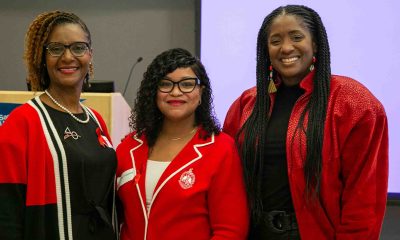Environment
City closes South L.A. oil drilling site
WAVE NEWSPAPERS — Los Angeles Mayor Eric Garcetti and Councilman Gil Cedillo announced March 13 that the city is taking action to permanently shut down part of an oil and gas drill site in the University Park neighborhood which went idle in 2013 when residents complained its fumes were making them sick.
By Wire Staff
LOS ANGELES — Los Angeles Mayor Eric Garcetti and Councilman Gil Cedillo announced March 13 that the city is taking action to permanently shut down part of an oil and gas drill site in the University Park neighborhood which went idle in 2013 when residents complained its fumes were making them sick.
The city and Cedillo have been exploring a number of ways to permanently close the full drill site that is owned by the Los Angeles Archdiocese and operated by AllenCo Energy. The city’s Petroleum Administrator, Uduak-Joe Ntuk, issued a letter notifying AllenCo Energy of the expiration of its lease agreement with the city due to a lack of production at the facility and said it is ending the company’s right to operate three wells that run beneath city-owned property from the site, which has a total of 21 wells.
“Our climate crisis demands a swift end to dependence on fossil fuels, and we’ll seize every opportunity to plug up a well,” Garcetti said. “By shutting down these wells for good, we are putting communities first, helping keep the air clean for our families, and moving us closer to a clean energy future that doesn’t depend on dirty oil.”
A woman who answered the phone at AllenCo said the company had no comment.
The St. James Exploratory Oil and Gas Lease at 814 W. 23rd St. operated by AllenCo was approved by city officials in 1963, which allowed the company to access oil under city-owned land.
After federal, state, and local agencies found that the company had violated environmental orders, AllenCo voluntarily ceased oil production at the site in 2013, but under the terms of the lease, any lapse in production allows the city to revoke the company’s operating authority under city property, according to Garcetti and Cedillo’s offices.
In 2016, City Attorney Mike Feuer said the oil field must remain closed until the operator shows it has adhered to all regulations, with even the smallest leak potentially triggering another closure.
Feuer sued the company in early 2014 and obtained an injunction forcing the facility operators to follow all relevant regulatory laws. AllenCo also agreed to pay $1.25 million in penalties, split equally between the City Attorney’s and District Attorney’s offices.
Cedillo’s office said in 2017 that the company was making efforts to reopen the St. James site, and stepped up efforts to prevent it from happening.
“The health, safety and welfare of residents are my paramount concern,” Cedillo said last week. “I share the community’s desire to ensure that this oil site does not re-open and resume operations. We reaffirm our commitment to our residents by severing the company’s contract and not renewing the expired leases with the city.”
Garcetti and Cedillo’s offices said in a joint news release that the city will “continue working with the landowner to identify alternative uses for the property that are more compatible with the needs and values of Angelenos.”
Food & Water Watch, which works in communities across L.A. to educate neighbors on the impacts of urban oil drilling, and build support for a 2,500-foot setback between oil drilling and homes, schools, parks and hospitals, issued a statement on the city’s actions.
“This is great news for our neighbors in University Park and our partners in People not Pozos, who have been fighting drilling in their neighborhood for years” said Food & Water Watch Senior Organizer Walker Foley. “We are encouraged that Mayor Garcetti is putting the health and safety of Angelenos first, and taking meaningful action that will also curb climate change. Now, we urge the mayor and Council President Herb Wesson to stand together to end all neighborhood drilling in L.A., which affects thousands of families.”
According to Food and Water Watch, almost half of all L.A. Neighborhood Councils are on record in support of setbacks between oil drilling and homes, schools, parks and hospitals.
This article originally appeared in the Wave Newspapers.
Alameda County
Electric UPS Delivery Fleet Coming to Oakland, Richmond, and SF
The project will replace the current Class 6 UPS delivery trucks with ZE battery electric vehicles. It will also install chargers at the Bay Area logistics centers. In total, 40 vehicles and chargers are coming to the facility near Oakland, another 10 in San Francisco and 10 more in Richmond.

The Richmond Standard
A total of 60 UPS delivery trucks serving logistics centers in Oakland, Richmond, and San Francisco will be replaced with electric versions as part of a partnership between the delivery business and the Port of Oakland.
The Port will use a newly announced award of $10.5 million in Environmental Protection Agency grants and $5 million from UPS to advance the fleet conversion.
The project will replace Class 6 UPS delivery trucks with ZE battery electric vehicles. It will also install chargers at the Bay Area logistics centers. In total, 40 vehicles and chargers are coming to the facility near Oakland, another 10 in San Francisco, and 10 more in Richmond.
The project will feature opportunities for green career pathways through workforce development and training.
“The Port of Oakland is grateful for additional investments to transition freight equipment and infrastructure to zero emissions,” Colleen Liang, the Port’s director of environmental programs and planning.
Richmond Mayor Eduardo Martinez said the “bold investment” will curb pollution, protect public health and provide good-paying green jobs.
“The City of Richmond welcomes this bold EPA investment in zero-emission heavy-duty vehicles,” Martinez said in a statement.
For more information, see the 2024 EPA Clean Heavy-Duty Vehicle Grant Project.
California Black Media
Gov. Newsom Goes to Washington to Advocate for California Priorities
Gov. Gavin Newsom traveled to Washington, D.C., for meetings with senior Biden-Harris Administration officials and members of California’s congressional delegation. During the week, he pushed for increased resources to improve public safety and quality of life in California.

By Bo Tefu, California Black Media
Gov. Gavin Newsom traveled to Washington, D.C., for meetings with senior Biden-Harris Administration officials and members of California’s congressional delegation.
During the week, he pushed for increased resources to improve public safety and quality of life in California.
“California is continuing our work to secure additional tools and resources to improve access to health care, clean air and water, and secure critical funding to support communities recovering from disasters,” said Newsom.
At the White House, Newsom met with President Joe Biden and key officials, advocating for disaster relief funding, healthcare expansion, and environmental protection. He also engaged in discussions with senior Biden-Harris officials, including Interior Secretary Deb Haaland, to address water quality improvements and the San Luis Dam project, which will support water supplies for two million Californians.
“Building on our strong partnership with the Biden-Harris Administration, California is working closely with the White House over the next two months to deliver the critical protections and resources our communities need,” Newsom said.
On Capitol Hill, Newsom met with California Senators Alex Padilla and Adam Schiff, along with other Congressional leaders, to emphasize the need to approve pending disaster funding, healthcare programs, and environmental protections. He also previewed California’s upcoming special session to proactively address potential federal challenges when President-elect Donald Trump is sworn into office.
Newsom’s discussions also focused on securing Medicaid waivers from the Center for Medicare & Medicaid Services (CMS) to enhance behavioral health services and reduce homelessness. The state seeks approval for the BH-CONNECT waiver, which would address behavioral health and homelessness, and the MCO Tax Waiver, which would provide over $20 billion for Medi-Cal to improve healthcare access.
Additionally, California is pushing for Clean Air Act waivers from the U.S. Environmental Protection Agency (EPA), which are crucial for enforcing air quality regulations. These measures are projected to prevent 11,000 premature deaths and provide $116 billion in health benefits over the next three decades, according to the Governor’s office.
Activism
LIVE! — TOWN HALL ON RACISM AND ITS IMPACT — THURS. 11.14.24 5PM PST
Join us for a LIVE Virtual Town Hall on the Impact of Racism hosted by Post News Group Journalist Carla Thomas and featuring Oakland, CA NAACP President Cynthia Adams & other Special Guests.
Thursday, November 14, 2024, 5 p.m. – 6:30 p.m. PST


Join us for a LIVE Virtual Town Hall on the Impact of Racism hosted by Post News Group Journalist Carla Thomas and featuring Oakland, CA NAACP President Cynthia Adams & other Special Guests.
Thursday, November 14, 2024
5 p.m. – 6:30 p.m. PST
Discussion Topics:
• Since the pandemic, what battles have the NAACP fought nationally, and how have they impacted us locally?
• What trends are you seeing concerning Racism? Is it more covert or overt?
• What are the top 5 issues resulting from racism in our communities?
• How do racial and other types of discrimination impact local communities?
• What are the most effective ways our community can combat racism and hate?
Your questions and comments will be shared LIVE with the moderators and viewers during the broadcast.
STREAMED LIVE!
FACEBOOK: facebook.com/PostNewsGroup
YOUTUBE: youtube.com/blackpressusatv
X: twitter.com/blackpressusa
-

 California Black Media4 weeks ago
California Black Media4 weeks agoCalifornia to Offer $43.7 Million in Federal Grants to Combat Hate Crimes
-

 Black History4 weeks ago
Black History4 weeks agoEmeline King: A Trailblazer in the Automotive Industry
-

 California Black Media4 weeks ago
California Black Media4 weeks agoGov. Newsom Goes to Washington to Advocate for California Priorities
-

 Activism4 weeks ago
Activism4 weeks agoOakland Post: Week of November 27 – December 3, 2024
-

 California Black Media4 weeks ago
California Black Media4 weeks agoCalifornia Department of Aging Offers Free Resources for Family Caregivers in November
-

 Activism2 weeks ago
Activism2 weeks agoButler, Lee Celebrate Passage of Bill to Honor Congresswoman Shirley Chisholm with Congressional Gold Medal
-

 Activism2 weeks ago
Activism2 weeks agoPost News Group to Host Second Town Hall on Racism, Hate Crimes
-

 Activism2 weeks ago
Activism2 weeks agoDelta Sigma Theta Alumnae Chapters Host World AIDS Day Event

























































